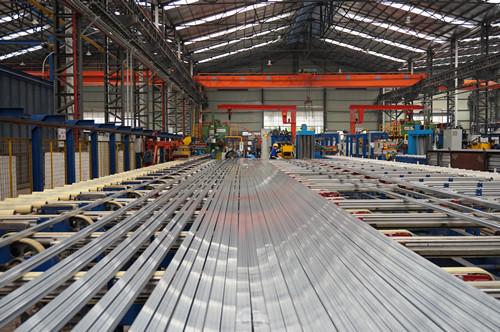6063 Aluminum Alloy: Properties, Applications & Anodizing Benefits
Introduction
6063 aluminum alloy is one of the most widely used materials in modern construction, automotive, and electronics industries. Known for its excellent extrudability, corrosion resistance, and surface finish, it is often referred to as the “architectural alloy” due to its dominance in building applications. From Audi’s automotive space frames to Norway’s Foresmo all-aluminum bridge, 6063 aluminum plays a crucial role in lightweight, high-strength designs.
Key Properties of 6063 Aluminum
6063 is an aluminum-magnesium-silicon alloy that offers:




Chemical Composition
| Element | Content (%) |
|---|---|
| Silicon (Si) | 0.2 – 0.6 |
| Magnesium (Mg) | 0.45 – 0.9 |
| Iron (Fe) | ≤ 0.35 |
| Copper (Cu) | ≤ 0.1 |
| Manganese (Mn) | ≤ 0.1 |
| Chromium (Cr) | ≤ 0.1 |
| Zinc (Zn) | ≤ 0.1 |
| Others | ≤ 0.15 (each) |
Mechanical Properties
-
Tensile Strength: 130 MPa (T4) – 190 MPa (T6)
-
Yield Strength: 70 MPa (T4) – 160 MPa (T6)
-
Elongation: 12% (T4) – 8% (T6)
-
Melting Point: ~600°C (1112°F)
Common Tempers & Heat Treatments
6063 aluminum is available in different tempers to suit various applications:
-
T4: Solution heat-treated & naturally aged
-
T5: Artificially aged after cooling from high-temperature shaping
-
T6: Solution heat-treated & artificially aged (highest strength)
-
F: As-fabricated (no special treatment)
(Insert image: Microstructure comparison of T4 vs. T6 temper)
Top Applications of 6063 Aluminum
1. Architectural & Construction



2. Automotive & Transportation



3. Electrical & Electronics



4. Industrial & Consumer Goods



(Insert image: 6063 aluminum profiles in construction & automotive uses)
Why Choose 6063 Aluminum? Key Benefits





Anodizing 6063 Aluminum: Process & Advantages
Anodizing enhances corrosion resistance, durability, and aesthetics.
5-Step Anodizing Process
-
Cleaning – Removes oils & contaminants
-
Etching – Creates a matte surface (optional)
-
Anodizing – Forms a thick oxide layer via electrolysis
-
Coloring (optional) – Dyes penetrate porous oxide layer
-
Sealing – Locks in color & improves corrosion resistance
(Insert diagram: Anodizing process flow)
Benefits of Anodized 6063 Aluminum





(Insert image: Anodized aluminum heat sinks in electronics)
Conclusion: The Future of 6063 Aluminum
6063 aluminum continues to dominate industries due to its balance of strength, formability, and cost-efficiency. With advancements in anodizing and extrusion technologies, it remains a top choice for sustainable, high-performance applications.
Whether for architectural designs, automotive frames, or advanced heat sinks, 6063 aluminum delivers unmatched versatility and reliability.

